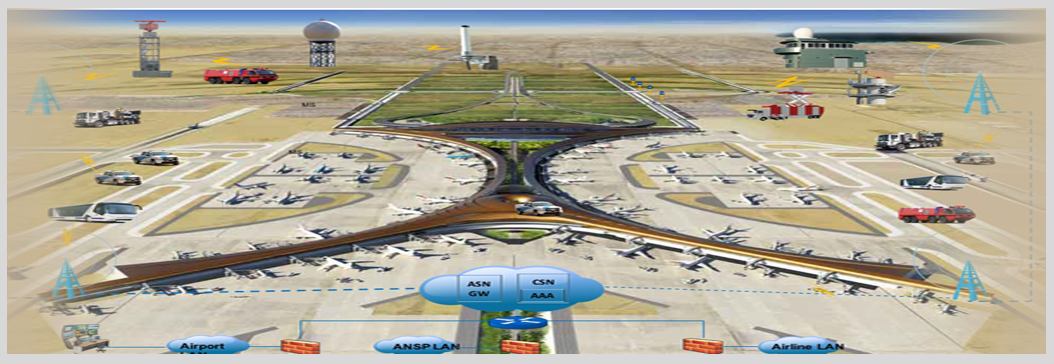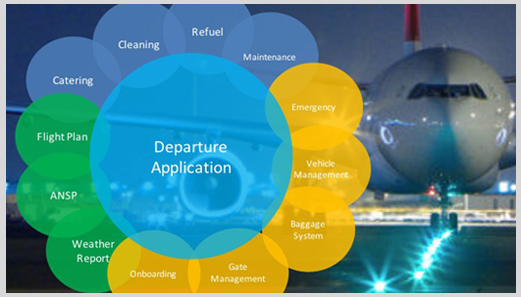Airport Management System (AMS) is an integrated operations management tool for systematic planning and execution of airport operations. AMS integrates the airports, networks and operations of a region, authority or country. AMS effectively manages the airport slot capacity and resources to handle the air traffic with optimal turn-around time and cost.
AMS does not replace anything; but integrates everything to enhance the safety, accuracy, consistency and efficiency in the airport operations. AMS improves the throughput and quality of operations with fewer resources at lower cost. Improved efficiency and predictability enhances the response capability of airport operations to unforeseen situations and emergency.
AMS can generate revenue streams to the airport operators and authority from application hosting, network and communication services. AMS readily supports the AeroMACS Communication System and its future applications planned by EUROCONTROL SESAR and FAA NEXTGEN programs.

AMS integrates the airport resources, services and their information in to an access network. It maintains the real-time status of these resources, services and information through the System-Wide Information Management (SWIM).
AMS integrates the following resource, services and information across the airports:
AMS maintains the inventory, location and status of each resource. It performs diagnostics to ascertain the status of the equipment. AMS maintains the catalogue of services, service providers and service status. AMS automatically allocates and assigns resources to the operations tasks and plans. AMS computes the performance metrics for the resources and service SLAs.

AMS builds a private secured internetwork and hosts this real-time information to the airport applications, administrators and subscribers. External networks of airline, ATC and other service providers are securely integrated in to the SWIM. AMS network supports voice, data, video and feature rich ATC applications.
AMS supports a variety of access communication technologies and systems: GSM, 3G, 4G, WiFi, WiMAX, AeroMACS, ADS-B, LAN and WAN. The access network can support voice, data, video and content rich applications depending on the bandwidth of the communication system deployed in the airport. AMS is capable of decoding ACARS and CPDLC messages to extract Airline and ATC information

AMS Operations Management has a planner, scheduler and controller. AMS provides customizable templates for typical airport operations planning. Plans are generated by the managers by nesting the predefined task sequences. Airport Applications define the operation task procedure. AMS helps identifying the task resources from the SWIM. AMS automatically assigns resources and executes the plan on the trigger-event. It continually monitors and automatically updates the actual status of the plan from the events.
During the course of execution, AMS extrapolates the final status of the plans from their current actuals. Dynamic failures, delays or resource-loss of a task are analyzed by WIS Analytics to produce the best alternative plans. The alternative plans are consistent with the other plans with respect to their dependency, conflicts and cascading effects.

With situational awareness including aircraft position, AMS implements Geo Fencing for the surface movement in the land and air sides of the airport. Mobile resources with AMS Client Applications are dynamically routed and controlled in to the safe zone. Dynamic Safe Limit Prediction, Traffic Management and Violation Alert features avoid collisions and incursions.
AMS provides intuitive GUI environment for planning, monitoring, controlling and reporting: Geospatial Moving Map, Graphical 3D Object Views and Tabular, Textual and Chart presentations.

AMS system features, provide an application hosting environment. AMS supports development of new applications or integration of existing airport applications. Applications serve as procedures of airport operations. AMS can host the following applications.
AMS is designed to meet the availability, confidentiality and integrity requirements of airport operations. AMS is built upon the following intuitive features. Refer to Celestain Integrated Communication Command Control for the system architecture and detailed technical description.
AMS hosts the airport applications and provides user-configurable communication and operation management environment. AMS integrates the existing airport applications. AMS applications use the operations management environment to plan, execute and monitor & control the operations.
AMS supports a wide range of heterogeneous communication systems and networks. AMS integrates the operations resources through the communication infrastructure.
AMS implements private networks and super network. It provides continuous real-time situational awareness to operations participants and managers across filed locations and command & control centers.
The Resource Management Service maintains the real-time status of the operation resources. Resources include people, operation equipment, communication equipment, navigation equipment, command & control clients, sensors, networks, information sources, transport vehicles and external services.
Operations manager can configure the airport applications, resource communication, operation tasks, procedure and decision logics using the templates.
AMS manages operations with levels of autonomy, as configured. It plans, executes and monitors & controls the operation with the operations manager’s decision support.
AMS System-wide Information Management (SWIM) maintains the status of each operations resource and plan. The information is system-wide synchronized in real-time. Resource-racing and task conflicts are resolved by the SWIM.
SWIM maintains the status of the entire system of resources and activities. Real-time status of an item is presented in the contexts of filed, local, regional and central views. Geospatial, graphical, video, audio and overlays presentations are inbuilt in to AMS. AMS implements advanced GPS algorithms to locate the resources with higher accuracy. AMS receives the aircraft position from the aircraft ADS-B broadcast.
AMS implements the airport geo fencing. Safety areas and limits are marked in the digitized airport map. AMS monitors and controls movement of aircrafts, vehicles, personnel to ensure safety in the surface movement.
Context-based Information Routing ability determines the sources-destinations of information in real-time operations context. This feature ensures that the required information for an operation is automatically transferred from its respective source(s) to the destination(s) at the required time.
AMS implements What-If-Scenario analytics on the SWIM and the operations plans to derive alternatives for the plan approaching an exception or failure. Best-effort alternatives are proposed to restore the operations plan.
AMS Health Monitor performs prognostics and diagnostics on the resources and the internal functions. Health Monitor coordinates with the System Performance and System Availability functions to maintain the system at the required performance and availability.
AMS implements multilayered end-to-end security against the threats and vulnerabilities. The security protocols and encryption algorithms are configurable by the user.
AMS System Performance function monitors the internal system metrics and Health Monitor’s reports. It implements prediction algorithms to forecast the system performance. It reports the performance status and predictions for administrator’s actions.
AMS System Availability function monitors the computing, communication and network resources. It automatically loads the redundancy configurations when a predefined exception, degradation or failure pattern occurs. It alerts the administrator when undefined exception, degradation or failures is detected.
AMS provides customizable report templates. AMS reports the system performance, availability, integrity and security status. It reports the status of resources and planned operations.
AMS performance, availability and security features are designed to assure operations success under all scenarios of loading, failures, threats and attacks: